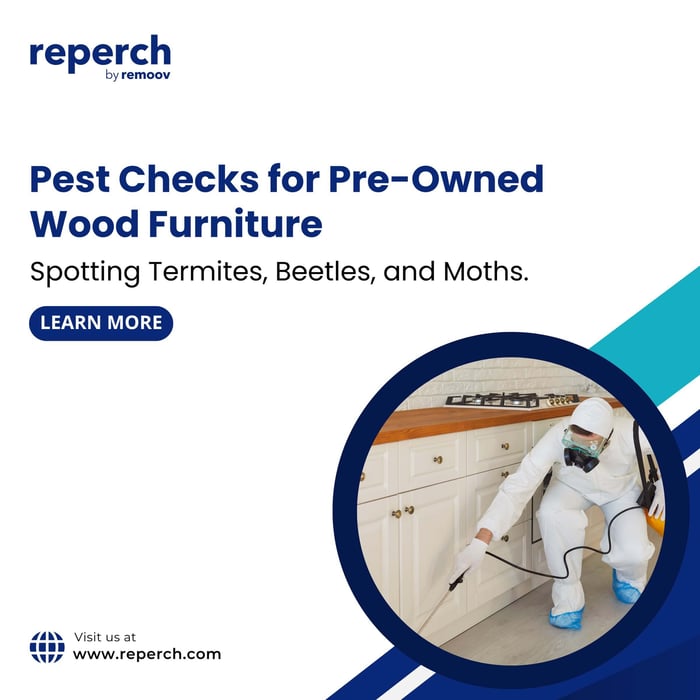Thrifted wood furniture offers incredible charm and value, but it can also come with hidden risks if not inspected properly. One of the most common issues? Pests. Termites, wood-boring beetles, and moths can take up residence in older furniture, especially if it’s been in storage or passed through multiple homes. If overlooked, these pests can damage your furniture and potentially spread into your living space.
This guide walks you through how to identify pest problems in secondhand wood furniture before you bring it home and what to do if you suspect an infestation.
Why It’s Crucial to Check for Pests
Wood pests are not always visible to the naked eye. Many live deep inside the furniture, and early signs of infestation are subtle. A minor beetle issue today could turn into a major structural problem later, especially if the pests migrate to your floors or built-ins.
Secondhand wooden pieces can come from garages, basements, or humid storage units. These environments often create ideal conditions for pests to thrive. Inspecting carefully can help protect both your furniture investment and your home.
Signs of Termites in Secondhand Furniture
Termites are destructive, silent invaders. These insects feed on cellulose inside the wood, leaving only a thin outer layer behind. The damage might be invisible until it’s severe.
Look for:
Thin, maze-like tunnels inside the wood
Small holes along surfaces or joints
Piles of light brown droppings (called frass)
Hollow-sounding wood when tapped
Weakness in legs or structural elements
Mud tubes or dried soil lines underneath or inside drawers
Prevention Tips:
Store secondhand pieces in sunlight for a few days before use
Spray with a borate-based wood treatment
Keep furniture off moist floors or soil contact
Seal unfinished wood surfaces
If the damage seems widespread or the wood feels soft throughout, it’s best to contact a pest control expert.
Spotting Powderpost Beetles
Powderpost beetles are known for leaving a trail of tiny holes and fine wood dust. They lay eggs inside cracks, and when larvae hatch, they chew tunnels through the wood as they mature.
Signs include:
Pin-sized round holes (exit points)
Fine sawdust near or under the furniture
Fragile or splintering edges
Clicking sounds from inside the wood at night
What to Check:
Undersides of dressers, chests, and cabinets
Reclaimed beams or rough-cut wood shelves
Inside drawers and joints where humidity builds up
Mild infestations may be handled with wood hardeners and protective finishes. Active infestations often require professional heat or chemical treatment to fully eliminate beetles hiding deep within the wood.
Watch Out for Moths in Upholstered or Lined Pieces
If the wooden furniture you’re buying has any upholstered or fabric components, there’s another pest to watch for: moths. These insects are not wood eaters but are notorious for attacking natural fibers like wool, felt, and cotton.
Warning Signs:
Small, irregular holes in fabric
Silken tubes or webbing on the fabric’s surface
Live or dead moths near the furniture
Crumbly edges or discoloration
Egg casings near seams or lining
Inspect Closely:
Inside ottoman storage lids
Cushioned wooden benches
Chairs with fabric seats or backs
Drawers lined with felt, velvet, or suede
Fabric infestations can spread quickly if left untreated. Vacuum thoroughly, use steam cleaning, and treat the piece with moth-repelling sprays. When in doubt, have any textile portions professionally cleaned.
How to Perform a DIY Pest Check Before You Buy
You don’t need pest control experience to identify most warning signs. Just follow these simple steps during your inspection:
Step 1: Scan for Visual Clues
Look at every visible surface. Flip the furniture upside down and check beneath, behind, and inside. Bring a flashlight to see into dark corners.
Step 2: Tap the Wood
Use a firm but gentle knuckle tap along solid areas. Hollow sounds could mean termites or beetles have carved out the inside.
Step 3: Look for Frass or Webbing
Piles of fine dust, tiny eggs, or silky threads can all point to insect activity. Use a white sheet under the item overnight to detect falling debris or insects.
Step 4: Smell the Piece
A musty or unusual odor may indicate pest buildup or mold. Trust your senses if something smells off.
Step 5: Quarantine Before Use
Even after purchase, keep the furniture in a garage or shaded outdoor area for a few days before placing it indoors. This gives you a buffer period to monitor for pests.
Natural Pest Control Methods for Secondhand Wood Furniture
If your inspection reveals light signs of insect presence, there are a few low-toxicity steps you can take:
Sunlight and heat: Direct sunlight for 1–2 days can drive out moisture-loving pests like termites or moths.
Diatomaceous earth: Safe for homes with pets, this powder can kill insects by dehydrating them. Sprinkle into corners and brush into cracks.
Essential oils: Cedarwood, clove, and neem oil are natural deterrents. Use diluted sprays or sachets for ongoing protection.
Borate sprays: Penetrates wood fibers and helps stop beetle or termite spread. Reapply once a year on untreated surfaces.
When to Call a Professional
If a piece is heavily infested or if pests appear after the item has entered your home, don’t wait. Termites and beetles can move from furniture into flooring, walls, or baseboards and cause structural damage over time.
Professional pest control companies can:
Perform a deep inspection of wood interiors
Use heat treatment or fumigation for hidden infestations
Apply sealants and borate gels for prevention
Advise on whether a piece is salvageable or should be discarded
Post-Purchase Prevention Tips
Once your furniture is clean and pest-free, use these strategies to keep it that way:
Seal raw or unfinished wood with varnish, shellac, or wax
Keep furniture dry and away from walls or moisture-prone areas
Inspect seasonally for signs of activity, especially in humid months
Elevate large pieces off the ground using pads or risers
Avoid direct soil contact for indoor-outdoor furniture
Reperch Tip: Buy Smart, Not Just Stylish
At Reperch, we want your vintage finds to be just as safe as they are stylish. That’s why we encourage all shoppers to inspect, clean, and protect secondhand wood furniture, especially if it's older, untreated, or has been stored in unknown conditions.
Our marketplace includes condition notes and quality checks to help you shop smarter. And if you're unsure about any piece you find, don’t hesitate to reach out with questions.
Final Thoughts
Pests may be tiny, but their impact on secondhand wood furniture can be big. Taking a few extra minutes to perform a pest check could protect your entire home from damage and save you hundreds in repair costs. With the right inspection habits and treatment steps, you can enjoy secondhand wood pieces that are full of charm and completely free of unwanted guests.








